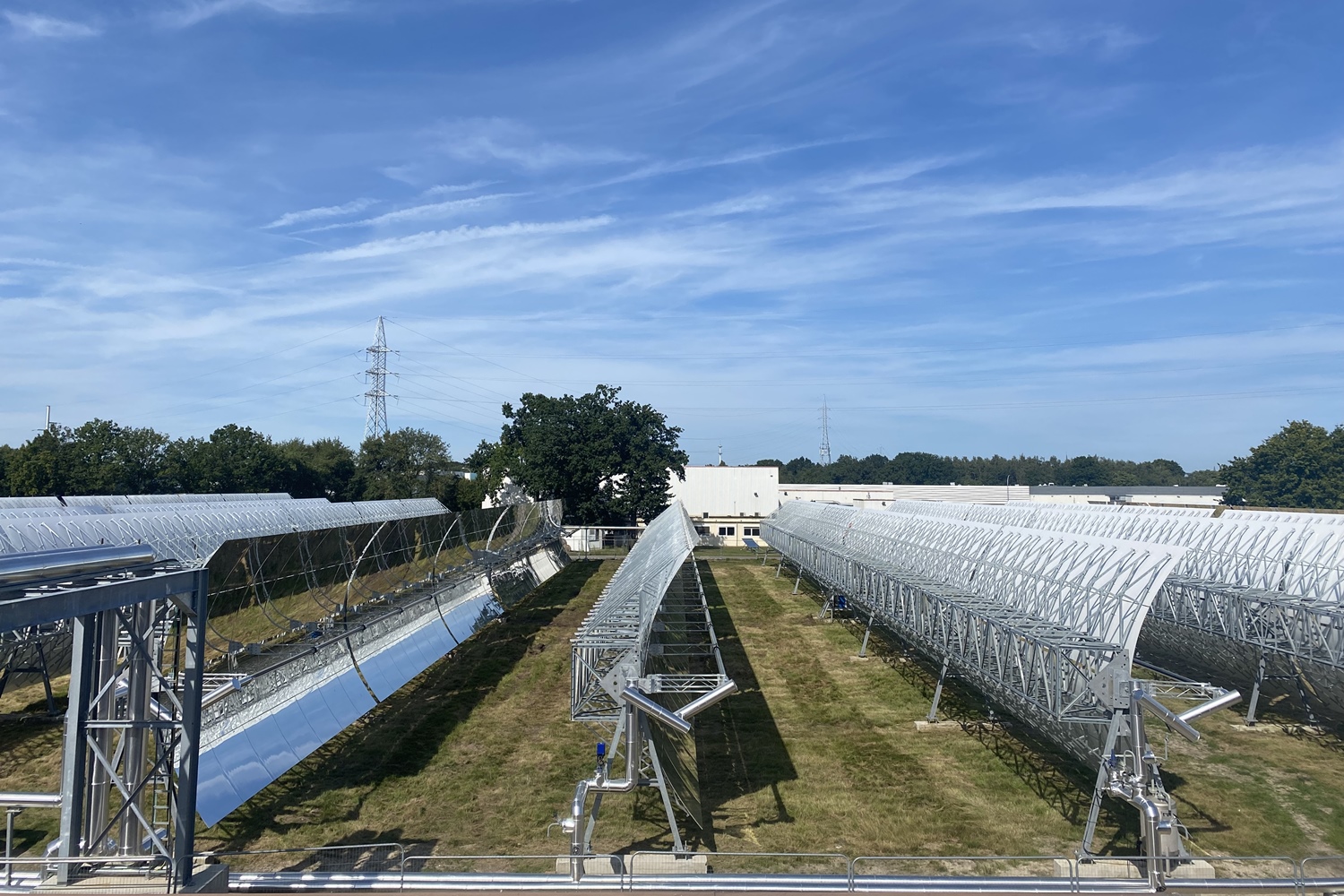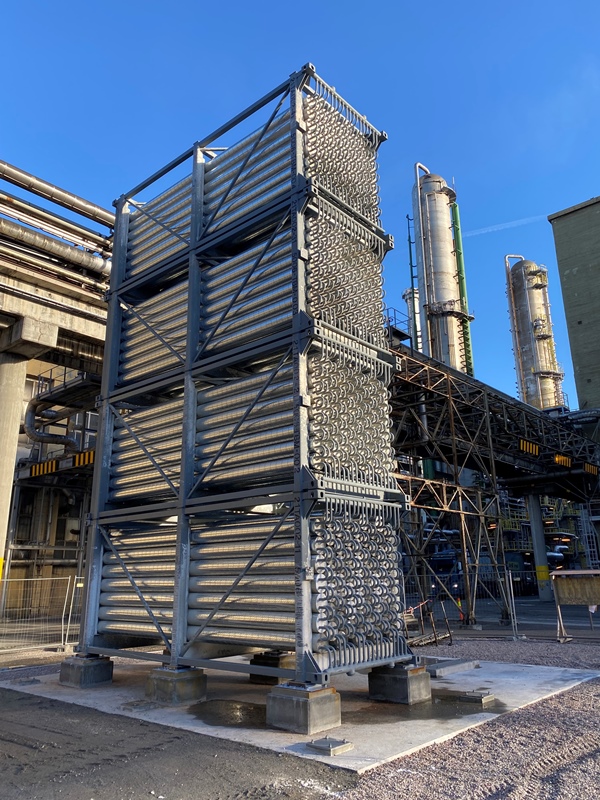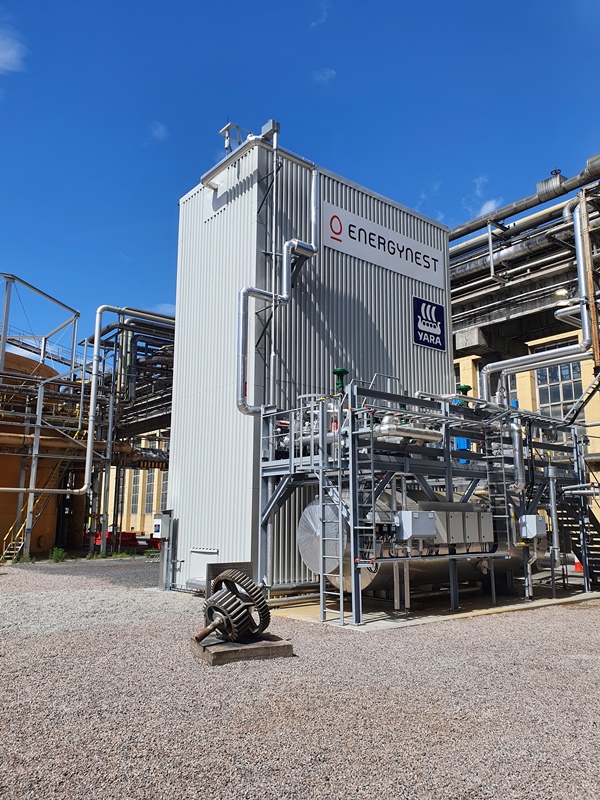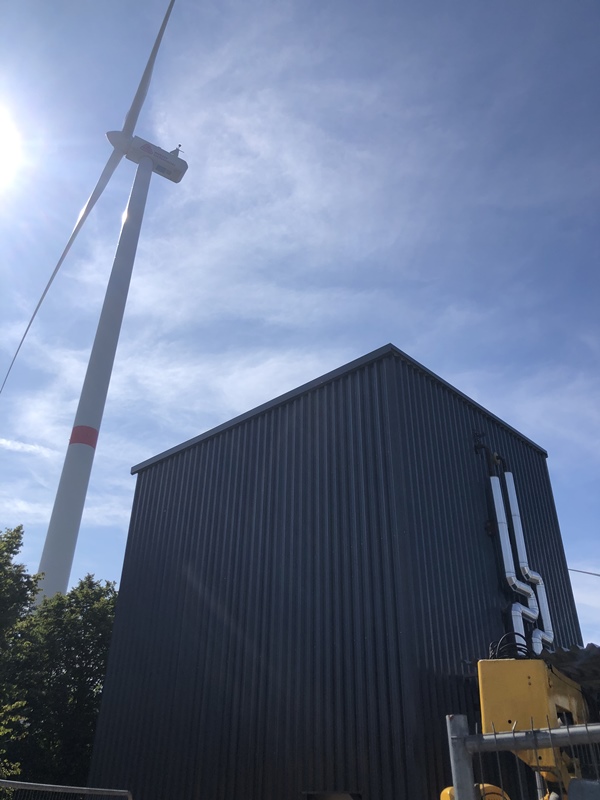P3 1-2/2024 en
Thermal Storage
A Building Block for the Decarbonisation of the Pulp and Paper Industry
Research & Innovation

View on part of the CST system which Energynest’s ThermalBattery is connected to in Turnhout, Belgium.

For the paper industry as an energy-intensive sector, climate neutrality poses a particular challenge. The key to successfully decarbonising the industry is to make steam and heat production both reliable and affordable. Thermal storage systems can already be a key to mastering this balancing act.
View on part of the CST system which Energynest’s ThermalBattery is connected to in Turnhout, Belgium.
In the public debate surrounding the energy transition, the challenge of industrial process heat has often been overlooked. Yet energy-intensive industrial sectors such as steel, chemicals, textiles, food and the paper industry in Europe consume almost 2,000 terawatt hours of energy per year for the production of process heat. In Germany, around half of the end energy consumption is accounted for by the generation of heat, with the generation of process heat making up around 23 per cent across all sectors according to the Federal Environment Agency. However, according to dena, the share of green heat is only approximately 15 per cent. Accordingly, process heat and process steam still offer enormous potential for savings and therefore also a significant lever for reducing CO2 emissions.
Despite considerable efforts, the CO2 footprint in the paper industry as a whole is still high, as natural gas remains the dominant energy source in fuel use with a share of 58 per cent, according to the industry association “Die Papierindustrie e.V.”. The industry has already invested heavily in energy efficiency measures such as heat recovery and combined heat and power plants. New technologies are now needed to achieve net-zero electricity generation as quickly as possible without disproportionately increasing production costs and, ideally, reducing overall consumption.
This is where thermal storage solutions come in, as they can help reduce dependence on fossil fuels and drive forward the integration of renewable energies in the industry.
Enormous potential for the decarbonisation of industrial heat
Energy storage is a key aspect of the energy transition: It is intended to end dependence on fossil fuels and drive the energy transition in global industry. Thermal energy storage in particular therefore offers enormous and tangible potential for the decarbonisation of industrial heat.
The reality remains that biomass is finite, geothermal energy is only economically available in certain parts of Europe and the efficiency of hydrogen from electricity for heat generation is currently 50 per cent at best. In addition, green hydrogen is unlikely to be available on a large scale in the near future and is likely to remain too expensive to be burnt at base load. Future-proof green solutions for energy storage such as Energynest's ThermalBattery, on the other hand, are already available today.
As such, thermal storage solutions should not only be considered in the context of achieving climate protection targets. They also offer great potential from a business perspective. Decarbonisation can make German industry as a whole more resilient and competitive by reducing its dependence on fossil fuels and thus minimising geopolitical risks. By implementing storage solutions, comparatively inexpensive and decentralised renewable energies can be integrated and supply as well as cost security can be guaranteed in the long term.
The ThermalBattery is made of carbon steel and Heatcrete, a special concrete developed in collaboration with HeidelbergCement. The heat storage units can be expanded on a modular basis, depending on how much storage is required. No moving parts were used in the design, which is why the storage unit has a long service life and is relatively low-maintenance. The service life can be 30 years or more.
The heat battery is charged by the direct flow of hot heat transfer fluid through embedded steel pipes from top to bottom, which transfers heat energy to the core storage material. In discharge mode, the flow is reversed: Cold heat transfer fluid is fed in at the bottom and then leaves the battery heated to release energy from the top of the ThermalBattery. This principle works just as efficiently with water and steam. The heat accumulator therefore acts as a steam cooler and condenser during charging, while it functions as a boiler and superheater during discharging.
The optimum operating range of the ThermalBattery is between 100° and 400°. The storage unit can be customised for different applications, opening up a wide range of uses in an industrial context. In the pulp and paper industry, there are several applications for heat storage systems. For example, heat storage units can be used for waste heat recovery or the generation of heat from renewable energies for drying processes.
Full integration of renewable energies
The paper industry is one of the five most energy-intensive sectors in Germany. In order to achieve climate neutrality in this industry, it is particularly important to replace the fossil fuels currently used to dry the paper. Here, electricity from renewable energy sources is a particularly good alternative to natural gas. Ideally, the electrification of heat and steam generation can completely eliminate the need for fossil fuels for sub-processes. However, without storage, production is only limited to daytime periods, even if steam is required throughout the day. Thermal storage can store excess energy for steam generation at night, enabling full decarbonisation.
Energynest has implemented this application in Belgium with its partner Avery Dennison, a leading manufacturer of self-adhesive materials. The project includes a concentrated solar thermal (CST) platform with 2,240 surface mirrors and a solar field with a peak yield of 2.7 GWh of thermal energy, as well as six thermal storage modules with a capacity of 5 MWh of thermal energy. Solar energy is used there to power some of the drying ovens in production, which are used in the coating process for the pressure-sensitive adhesive products manufactured at the site. Thermal energy that is not generated as required is stored in the ThermalBattery and released at night or during other peaks in demand, thus avoiding the use of fossil fuels and contributing to a further reduction in emissions.
The use of thermal storage at a paper manufacturer, for example, can lead to significant savings with an assumed storage size of 8 MWth in combination with an electrode steam boiler of 5 MWel. In this scenario, Energynest calculates that consumption could be reduced by an average of around 11 GWh of natural gas and 2,300 tonnes of CO2 per year. The total savings per year could thus amount to up to 1.3 million euros per year, which would lead to amortisation of the system after four years of operation.
Significant improvement in energy efficiency
In addition to electrification, thermal storage systems can also realise previously untapped potential in waste heat. The recovery of excess heat and its storage for later reutilisation as primary energy in a type of process heat recycling also reduces dependence on fossil energy sources, saves energy costs and reduces emissions. Many paper manufacturers are already working with heat recovery systems. Thermal storage systems can complement these and enable flexible control of heat recycling.
This process is used, for example, by one of the world's largest fertiliser producers, Yara, in Porsgrunn, Norway. The steam-based thermal storage units - the first of their kind in industrial use - enable Yara to recover energy that is not generated as required in the form of steam and feed it back into the steam network for various plant processes, depending on the requirements. This form of steam grid balancing ensures that fewer fossil fuels have to be used to generate additional steam and that fluctuations in production and energy feed-in can be balanced out.
Conclusion
For many fields of application for thermal storage, there is no longer any need for new political measures or special subsidies - especially not with high energy prices and the prospect of further increases in CO2 prices. The pressure on the industry to act is enormous: rapid implementation and scaling of climate-friendly technologies are now crucial. To achieve this, German industry must abandon its reluctance, turn energy procurement from an issue of suffering into a solution and combine various technologies into a sustainable supply portfolio.
Thermal storage can help secure the industrial heat and steam supply and at the same time become a core component of climate-neutral production processes. They are both sustainable and economical, quick to implement and scalable. This makes thermal storage systems important building blocks for the energy transition in the pulp and paper industry.
Energynest offers a flexible and cost-efficient thermal energy storage system (TES) for customers in the power generation, energy-intensive manufacturing and renewable energy sectors. The thermal battery solutions decarbonise the energy supply by electrifying industrial heat and by recovering and reusing waste heat into energy on demand. Energynest also offers large-scale energy storage for solar thermal and other zero-emission power plants. Founded in 2011 and headquartered in Billingstad with offices in Hamburg, Seville and Rotterdam, the company was ranked 3rd in the Global TOP100 Carbon Reducing Innovations by Mission Innovation.
Christian Thiel has been CEO of Energynest since 2014 and has been working at the interface of industry, innovation and energy for over 20 years. He has held management positions at Senvion (formerly REpower), McKinsey, UBS Investment Bank and worked as a project manager at the BMW Group. He holds a doctorate in marketing and was a visiting scholar at Harvard Business School and the Kellogg School of Management as part of his dissertation.
Author: Dr. Christian Thiel, Chief Executive Officer, Energynest.
Editor: sbr
Images: Energynest










